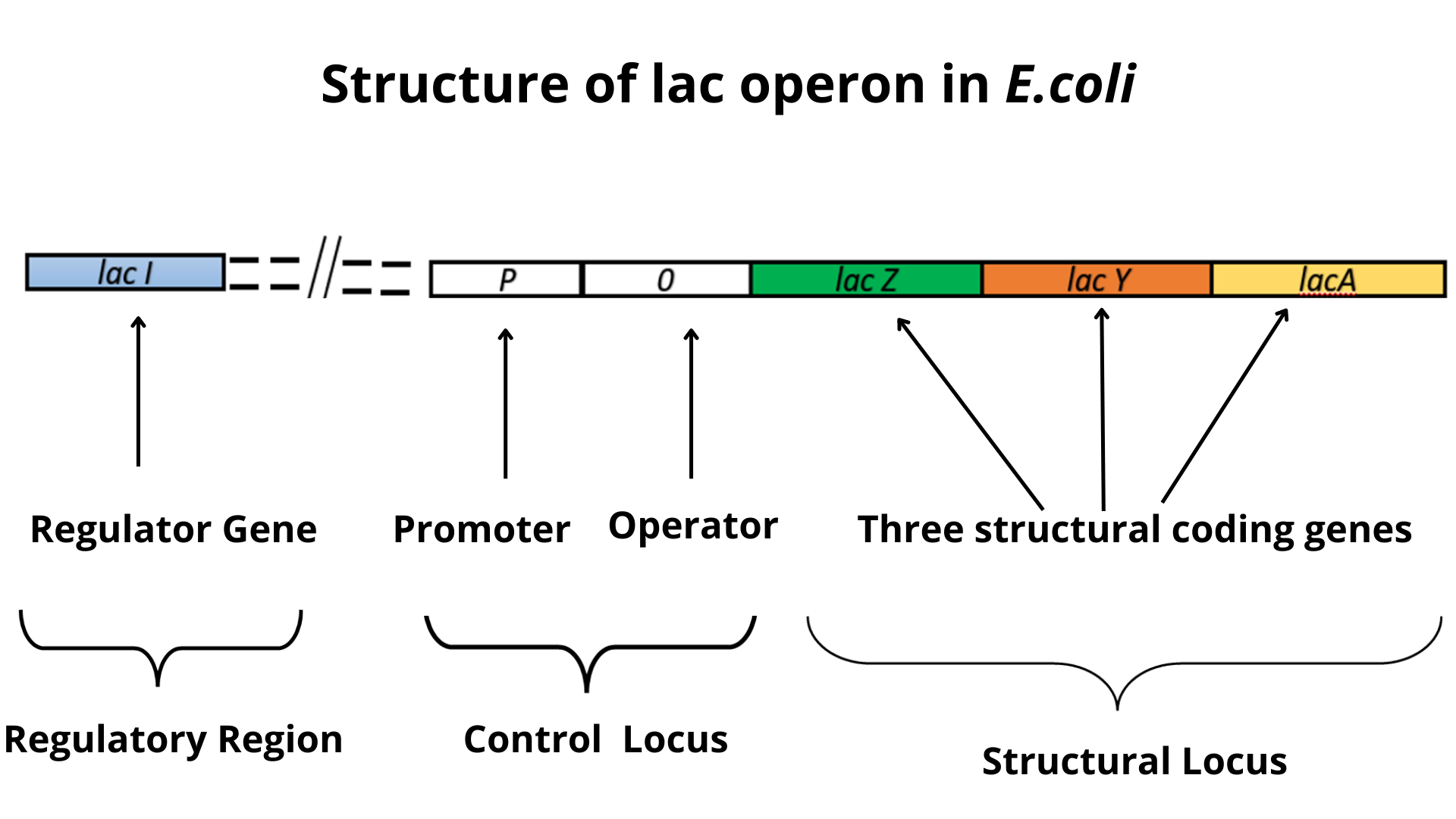Operons are set of genes which are present on chromosome of all prokaryotes. Lac operon is one such operon which helps E. coli to to metabolize lactose. In E. coli glucose is the primary carbon source for energy production. E coli uses glucose molecule for glycolysis pathway and produces energy is form of ATP. The metabolism and survival of E. coli is dependent on this energy. For using glucose as energy source there is no need of induction of operons. E coli preferentially uses glucose molecules first. When level of glucose depletes only then it uses other carbon source to produce energy energy. But when lactose is present in the medium then e coli shows expression set of a gene known as Lac Operons. Lactose molecules induce an operon an chromosome. Lets see the structure and function of lac operon.
Lac operon structure :
There are three important regions on lac operon. These are regulatory region, control locus, and structural locus. See following diagram showing structure of lac operon.

Regulatory region :
In this region Regulator gene Lac I is present. Regulator gene Lac I codes for repressor protein .
Control locus:
This control locus has two important regions. First Region is promoter sequence where RNA polymerase binds and initiates transcription. Second region is operator sequence where repressor protein binds.
Structural locus :
This locus has three genes such as Lac Z, Lac Y, Lac A which codes for three different enzymes .
Lac Z gene codes for enzyme Beta Galactosidase . This enzyme hydrolyze the lactose into Galactose and glucose.
Lac Y gene codes for permease protein which brings lactose from outside into cytoplasm through membrane.
Lac A gene codes for Transacetylase enzyme.
Regulation of Lac operon:
Lac operon is regulation take place by two process. Regulation can happen either by repression or Induction of lac operon.
Lac operon Repression by Repressor protein:
The product of lac I gene is repressor protein. Repressor protein is an allosteric tetramer protein. It has two binding site on it. First binding site is for operator sequence on DNA and second binding site is for allolactose. When lactose is absent at that time repressor protein is active. It binds to operator region. During transcription RNA polymerase tries to initiate transcription by binding at promoter. But RNA polymerase can not move ahead because repressor is blocking the path. As a result there is no transcription of lac lacZ, lacY, lacA genes. So in absence of lactose, lac operon is under repression by repressor protein.
Lac operon Induction by Lactose :
Initially very few permease and b galactosidase protein are present inside E. coli even when there is lactose is absent . When lactose in large quantity is present in medium at that time few lactose molecules enter inside e coli cell through permease membrane protein. Now lactose gets hydrolyzed by beta galactosidase enzyme into lactose and glucose . At the same time some lactose molecules gets converted into allo-lactose. This allolactose has affinity of binding to repressor protein. Allolactose binds to repressor protein and repressor protein becomes inactive. Now RNA polymerase binds to promoter and transcribes all three genes. After translation these three functional enzymes are made in large quantity Which then help in hydrolysis of lactose for energy production.
Watch following nice video on how regulation of lac operon take place.
Catabolite Repression :
When e coli is grown in presence of glucose and lactose, it uses glucose preferentially i.e. First it finishes all glucose and then only it uses lactose. So in presence of glucose there is no induction of lac operon even when there is lactose in the medium.
Glucose + Lactose both present :
High level of glucose results in glycolysis and energy releases in the form of ATP. Because of this there is increase in level of ATP. When level of ATP increases then, level of cAMP Phosphodiesterase also increases. Increase in the level cAMP Phosphodiesterase causes decrease in the level of the cAMP. cAMP is small nucleotide. cAMP- Cyclic Adenosine Monophosphate. Due to this low cyclic AMP levels , RNA polymerase can not bind efficiently at promoter region. There is very little or no expression of lac operon genes.
Glucose absent, Lactose present
In absence of glucose the adenylate cyclase enzyme is active due to which there is increase in cAMP level. This cAMP is binds to cAMP receptor protein or CRP protein. This CRP protein is also called as CAP protein. (CAP: Catabolite Activator PROTEIN) When cAMP binds to cAMP receptor protein (CRP)there is conformational change occur in the cAMP receptor protein (CRP) and it becomes active. There is formation of a cAMP – CRP complex. This complex binds to a specific site on the DNA near the promoter known as cyclic amp response element (CRE). This CRE element is nothing but a conserved sequence located near -15 bp upstream of promoter. When cAMP–CRP complex binds to CRE region this cAMP – CRP complex makes contact with the RNA polymerase. This Protein–protein contact with RNA polymerase causes RNA polymerase binding at promoter increases twenty folds.
So in presence of cAMP–CRP complex RNA Polymerase get stimulated and there is high level of expression of lac genes and lactose utilization take place.
When glucose is high in cell then there is low level of cyclic AMP
When glucose is low at that time there is level of cyclic AMP is high
You can watch the following animation video on Catabolite repression.
Please check your understanding on lac operon by Solving MCQ given below.
